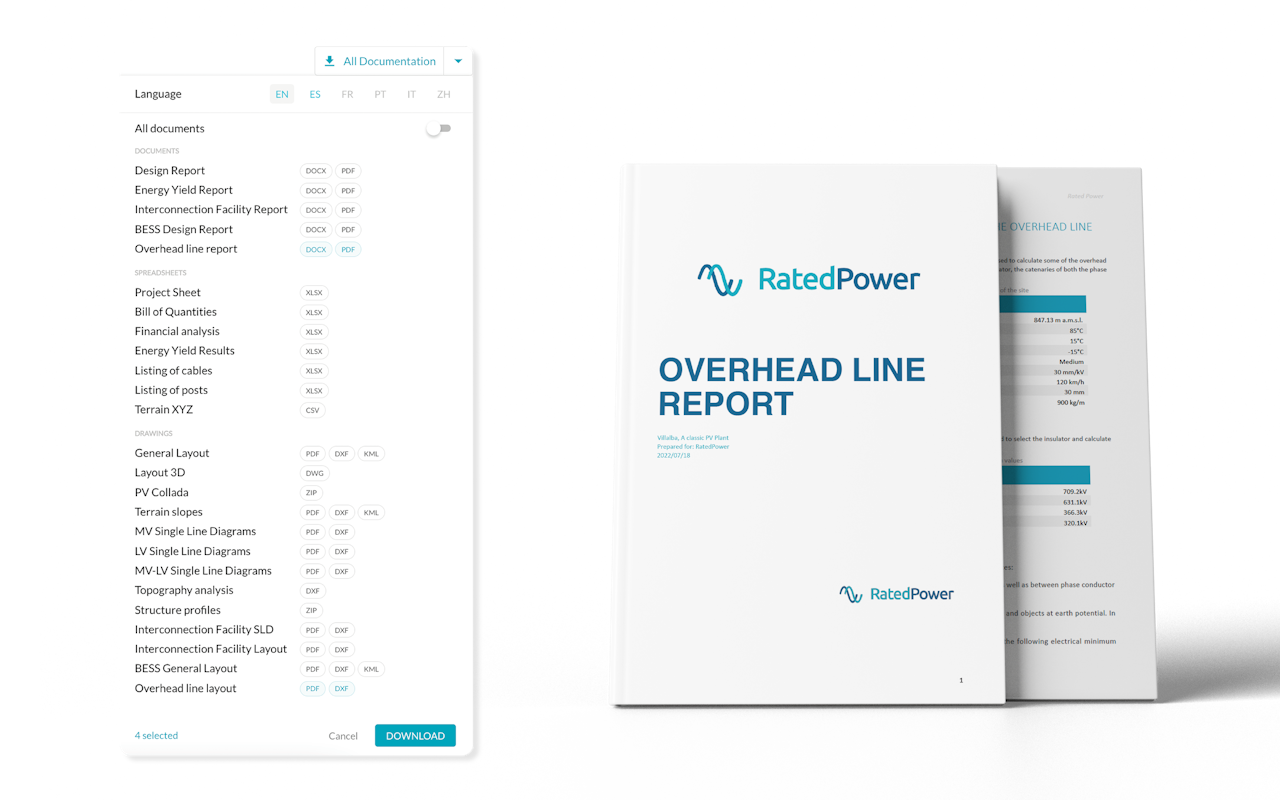- Solar energy blog
- How to design overhead power lines for utility-scale green energy
How to design overhead power lines for utility-scale green energy
Overhead power lines play a vital role in the overall green energy infrastructure. Here we outline how to design overhead lines using RatedPower.


Soukayna Jermouni
Product Manager, Interconnection
Software developer and Energy engineer with a MSc in sustainable energy management. Joined RatedPower 4 years ago, originally as a customer success member, her understanding of the product’s users’ needs allowed her to become a project manager and developer; a position through which she developed both her understanding of the grid interconnection and managerial skills. Soukayna currently serves as a product manager of interconnection. She ensures that the interconnection features in the product correspond to the client’s needs and meet the engineering requirements.

Content
Achieving the ambitious goals of a clean energy transition requires more than simply installing renewable power generation capacity. It also includes the associated infrastructure to transmit the electricity to where it is needed so that it can replace fossil fuel generation.
Overhead lines are a key component of the power transmission and distribution grid, carrying wind and solar energy to homes and businesses, as well as to electric vehicle chargers and other electricity consumers. But overhead lines are often given little thought in discussions surrounding renewable power installations. What do you need to know about overhead lines and how to incorporate them into utility-scale project design?
What is an overhead power line?
An overhead line is the electrical cable and associated equipment that is used to transmit power between a generation plant and the transmission and distribution grid or to connect substations. The line is suspended overhead by towers or poles and can be part of the transmission network or distribution network.
Transmission lines transmit power at voltage levels of 46 kilovolts (kV) and above, which is too high to deliver to homes and businesses. The voltage is reduced via transformers and delivered through distribution lines.
The electrical performance of an overhead line is determined by four main parameters: resistance, inductance, capacitance, and shunt conductance.
Overhead line design considerations
The design of an overhead line will depend on whether it is a transmission or distribution line and needs to take into consideration several pieces of equipment, such as:
Towers or supports
Conductors of various types
Earth, or ground, wire to protect the conductors
Insulators
Accessories.
Overhead line design should go through several planning stages to guarantee the system’s reliability and availability. Components such as the conductor, earth wire, insulators, and circuits must all meet electrical and mechanical requirements.
The strength of the line should also be able to withstand different weather conditions depending on the location, such as heavy snowfall, high temperatures, or strong winds.
The choice of the tower or support design will also depend on the grid operator, the utility and the country where it is located.
How to design overhead lines
When designing an overhead line, you need to take into account several factors concerning the positioning of the components:
Geometry
The geometry of the tower top is crucial to the design of an overhead line. The dimensions are determined by minimum phase-to-earth, phase-to-phase and ground electrical clearances. There are several top tower types and geometries worldwide incorporating different safety clearances for various voltage levels and regulatory requirements.
Sag and span
The position of the conductors and earth wire at the tower and the sag of the line at mid span change with climatic conditions. The sag refers to the vertical distance between the highest point of the electrical pole or tower and the lowest point of the conductor between two electrical supports. The horizontal distance between supports is the span. The catenary curve of the conductor is described by its sag under different state changes while considering its clearance to the ground.
Connections
The forces on tower connection points are an important consideration because they can cause compression on one side of the tower and tension on the other side. Calculating forces takes into account wind and ice loads, maintenance and conductor tension.
Route
The spotting, or optimizing, of the towers is an important consideration from the start of the design stage, as the route of the overhead line is key to the project’s permitting and approval process.
Cost
The cost of installing an overhead line depends mainly on the cross-sections of the conductors and the height of the towers as well as their foundations.
Overhead line planning with RatedPower
The interconnection element is a crucial part of a solar project, and the application and engineering processes can be complicated and take a long time to complete.
Our solar design platform is one of the few applications that can automate the basic engineering of an overhead line to reduce the development time. In RatedPower, a user can manage the design and basic engineering of an overhead transmission or distribution line with just a few clicks.
From only an initial path, the results can provide an overview of utilities as well as the scope of the interconnection section of the project and the approximate cost.

Choosing the right PV structure for your project leads directly to greater efficiency, power output, and ROI. In this post, we outline the three main PV plant structures and share RatedPower analysis of their performance. Learn more on the blog post: Choosing PV structures: Trackers vs Fixed vs East-West (Case study inside!)
In the software, a user can import a path for the line and the algorithm will automatically evaluate the feasibility of the line. It will then spot the towers along the route, select the type of equipment needed, calculate the electrical and mechanical parameters, calculate the catenary and tower forces, design the top geometry of the towers, select towers from known manufacturers, and calculate the losses and the power factor at the receiving end of the line.
This enables you to design the interconnection between the plant’s substation and the point of interconnection with ease. Depending on the voltage level, the overhead will be designed as a distribution or transmission line.
The software generates complete PV system engineering documentation including a design report and a complete drawing of the line in .pdf and .dxf formats.
This overhead line feature in RatedPower opens the door for new users in electric utilities to be able to design optimized transmission and distribution lines in only a few minutes.
Project developers can also go beyond the plant and substation designs by adding more engineering design into the point of interconnection, giving users all the necessary results and data that they need for an overhead line.
Use RatedPower to optimize your solar plant interconnection
Overhead lines form an important part of the infrastructure that will enable utility-scale solar power projects to displace fossil fuel generation. If you are developing a large solar project, contact RatedPower to find out how we can help to automate and optimize your project.
Latest stories
Related posts
Technology and engineering
Innovation in renewable energy: Developments expected in 2025
We look at the 10 biggest renewable industry developments that are making a green future possible, including perovskite solar cells, green hydrogen, and more.
Updated 18 MAR, 25

Market analysis
Breaking down solar farm costs: Free template inside
Updated 27 SEP, 21

Market analysis
Solar energy in Australia: a 2021 market analysis
Updated 11 MAY, 21

- RatedPower
- Solar energy blog
- How to design overhead power lines for utility-scale green energy

